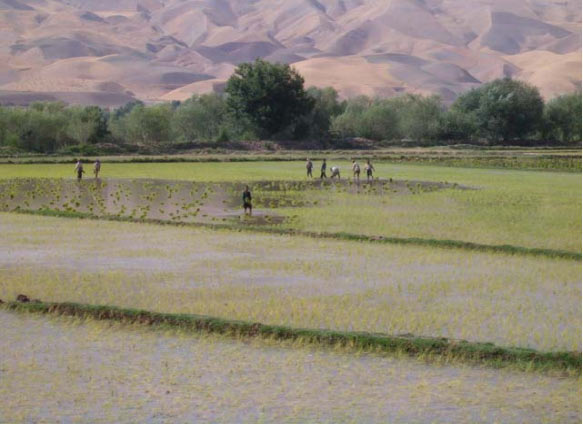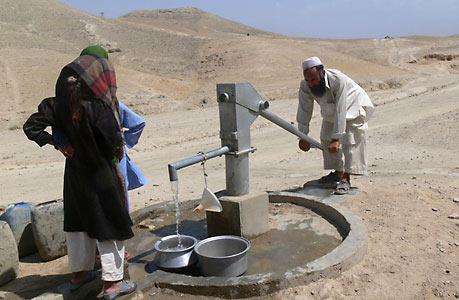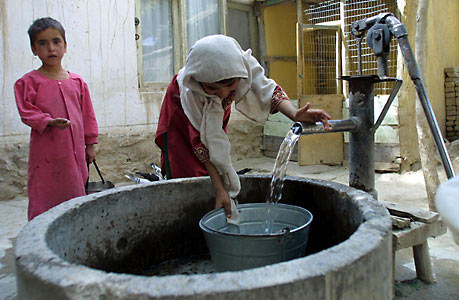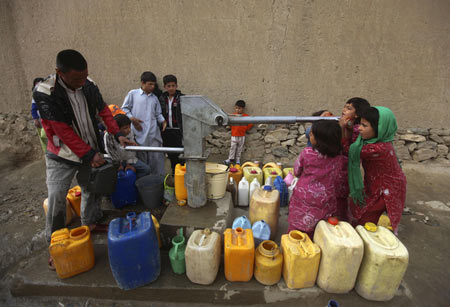
Water Resources Management in Afghanistan: The Issues and Options
Traditional Irrigation Systems
The history of irrigated agriculture in Afghanistan goes back to more than 4,500 years ago (ancient settlement near Kandahar). Except for a few areas where rainfed agriculture can be practiced, agricultural production in most of the country is not possible without irrigation as the rainfall is either meager or unreliable. The allocation of water and land is closely related to customs and traditions of the sedentary population, and maintenance works of irrigation schemes have always been a well-defined activity in the farmers’ seasonal calendar.

Irrigation systems in Afghanistan can be divided into two categories:
Small-scale informal surface water systems:
These are centuries old systems. Water is supplied by stream flow diverted with the help of temporary brush weirs. They are often located in remote valleys along a stream or river and vary in size (up to 100 ha). These systems are constructed and maintained in a traditional informal manner on a communal village basis and water rights are also determined and recognized in the similar manner.
Large-scale informal surface water systems:
These systems are mainly located in the plains and along the main river valleys. They can cover an area of up to 200,000 ha. Although they are called informal, their operation and maintenance was highly structured involving different communities of different ethnic origin. Many villages can share water from such a system. According to the water laws of 11981 the amount of water needed for irrigation is determined according to area under cultivation, the kind of crop, the irrigation regime, the water rights document, the local practices and the amount of water in its source. The regulations concerning the use of water in agriculture in Afghanistan is given in Annex I. Each village has at least one water master (mirab) who delegates his authority to sub water masters responsible for the allocation of water to different fields of the scheme. Lawyers (vakil) support the mirabs in disputes over water rights and provide the linkage to government authorities for the registration of land and water rights. Repair and maintenance works are executed by mobilizing large gangs of labor for a long period, and farmers in the command area have to contribute in labor, cash or kind. Historically, large parts of these schemes have been abandoned because of the impact of wars, water logging and salinization, particularly in the Harirud, Farah Rud, Balkhab, Murghab and Helmand valleys.



Shallow wells (Arhad) system:
Ground water is lifted from shallow wells with the help of Persian wheel (arhad) supplying irrigation water to the fields of an individual farmer. The size of the irrigated land does not exceed 3 ha. The total number of shallow wells in Afghanistan is 8595 that irrigate around 12060 ha of land.
Springs:
When groundwater table reaches above the ground surface, it starts flowing on the surface and form springs. There are about 5558 springs in the country, which irrigate about 188,000 ha of land. Springs are directly dependent upon the groundwater level. When the groundwater level goes down, e.g. during drought years, it results in a reduction of outflow from springs. That is why some of the worst drought stricken areas of the country are located in region where they depend heavily on spring water for irrigation. Spring irrigation is common in the east and in the south.
Karez (qanat) systems:
Karezes are underground galleries that tap groundwater from the aquifers of alluvial fans. Underground tunnels with gentle slopes carry water from the source to the settled areas. Karezes are usually small in dimensions but may be many kilometers in length. On average, their discharge varies between 10 l/s to 200 l/s but can in some cases reach up to 500 l/s. Karez water is used for irrigation purposes (irrigated area ranges from 10 ha to 200 ha) as well as for drinking water supply.
The technique has been used for thousands of years in Afghanistan, Iran, the Middle East and North Africa. It is one of the most economical methods of tapping groundwater for irrigation purposes. It is environmentally safe and water is drawn by use of gravity. There are 6741 karezes in the country. These karezes irrigate about 163,000 ha of land. Karez irrigation is common in the south and southwest of the country and less in the north of the country. One of the disadvantages of the karezes is that there is no mechanism to stop water from flowing during winter or when there is no need for irrigation. In each karez about 25% of total annual volume of water is wasted. Province-wise distribution of different irrigation systems in Afghanistan is given in Table.
Province-wise distribution of different irrigation systems in Afghanistan
| Province | Canals | Springs | Karez | Wells | Mills |
| Badakhshan | 212 | 82 | 54 | 730 | |
| Badghis | 120 | 50 | 30 | 500 | |
| Baghlan | 109 | 63 | 565 | ||
| Balkh | 250 | 92 | 3 | 82 | 912 |
| Bamyan | 179 | 137 | 300 | 651 | |
| Farah | 312 | 94 | 352 | 327 | 260 |
| Faryab | 157 | 79 | 960 | 867 | 1030 |
| Ghazni | 818 | 604 | 1516 | 636 | 994 |
| Ghor | 804 | 570 | 4 | 263 | 500 |
| Helmand | 227 | 135 | 276 | 60 | 516 |
| Heart | 302 | 153 | 228 | 450 | 1302 |
| Jawzjan | 382 | 87 | 2 | 443 | 475 |
| Kabul | 177 | 81 | 321 | 436 | 616 |
| Kandahar | 279 | 258 | 631 | 252 | 383 |
| Kapisa | 285 | 71 | 49 | 176 | 638 |
| Kunarha | 223 | 67 | 13 | 681 | |
| Kunduz | 88 | 55 | 363 | ||
| Laghma | 45 | 3 | 561 | ||
| Logar | 154 | 169 | 124 | 91 | 433 |
| Nangarhar | 274 | 210 | 495 | 15 | 1001 |
| Nimroz | 193 | 2 | 18 | 140 | 133 |
| Paktia | 625 | 392 | 528 | 800 | 171 |
| Parwan | 120 | 93 | 34 | 756 | |
| Samangan | 20 | 73 | 7 | 271 | 190 |
| Takhar | 316 | 288 | 509 | 653 | |
| Uruzgan | 363 | 429 | 84 | 210 | 1266 |
| Wardak | 589 | 519 | 336 | 822 | |
| Zabul | 199 | 756 | 743 | 148 | 373 |
| 7822 | 5558 | 6741 | 6598 | 17475 |
Source: Water Resources Management in Afghanistan: The Issues and Options by Asad Sarwar Qureshi, IWMI, Working Paper 49
